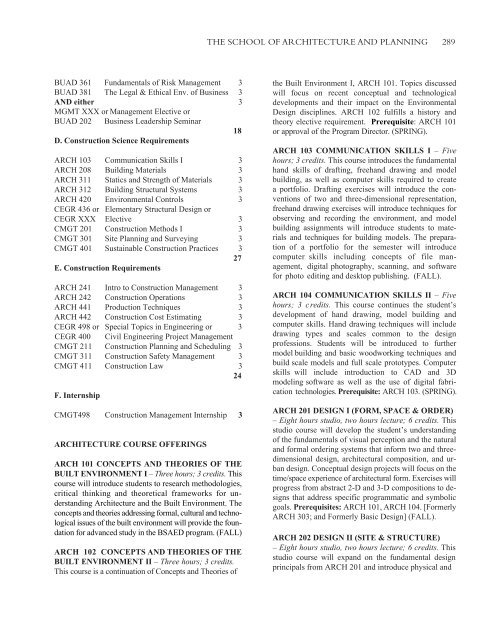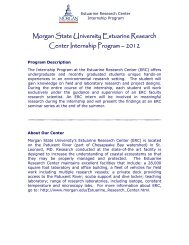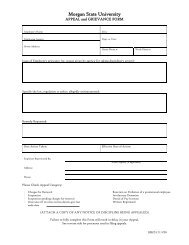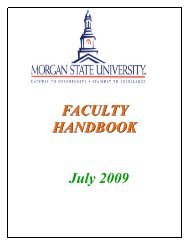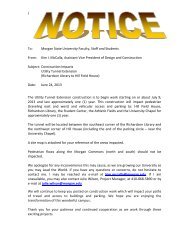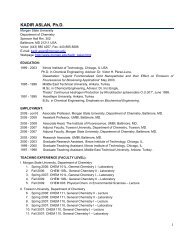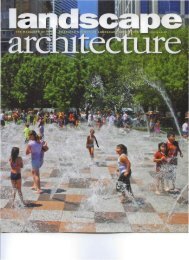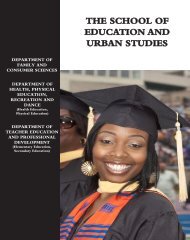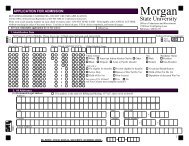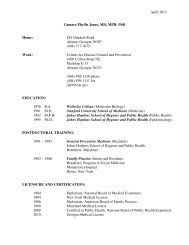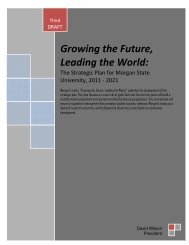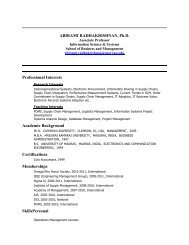the school of architecture and planning - Morgan State University
the school of architecture and planning - Morgan State University
the school of architecture and planning - Morgan State University
Create successful ePaper yourself
Turn your PDF publications into a flip-book with our unique Google optimized e-Paper software.
THE SCHOOL OF ARCHITECTURE AND PLANNING 289<br />
BUAD 361 Fundamentals <strong>of</strong> Risk Management 3<br />
BUAD 381 The Legal & Ethical Env. <strong>of</strong> Business 3<br />
AND ei<strong>the</strong>r 3<br />
MGMT XXX or Management Elective or<br />
BUAD 202 Business Leadership Seminar<br />
18<br />
D. Construction Science Requirements<br />
ARCH 103 Communication Skills I 3<br />
ARCH 208 Building Materials 3<br />
ARCH 311 Statics <strong>and</strong> Strength <strong>of</strong> Materials 3<br />
ARCH 312 Building Structural Systems 3<br />
ARCH 420 Environmental Controls 3<br />
CEGR 436 or Elementary Structural Design or<br />
CEGR XXX Elective 3<br />
CMGT 201 Construction Methods I 3<br />
CMGT 301 Site Planning <strong>and</strong> Surveying 3<br />
CMGT 401 Sustainable Construction Practices 3<br />
27<br />
E. Construction Requirements<br />
ARCH 241 Intro to Construction Management 3<br />
ARCH 242 Construction Operations 3<br />
ARCH 441 Production Techniques 3<br />
ARCH 442 Construction Cost Estimating 3<br />
CEGR 498 or Special Topics in Engineering or 3<br />
CEGR 400 Civil Engineering Project Management<br />
CMGT 211 Construction Planning <strong>and</strong> Scheduling 3<br />
CMGT 311 Construction Safety Management 3<br />
CMGT 411 Construction Law 3<br />
24<br />
F. Internship<br />
CMGT498 Construction Management Internship 3<br />
ARCHITECTURE COURSE OFFERINGS<br />
ARCH 101 CONCEPTS AND THEORIES OF THE<br />
BUILT ENVIRONMENT I – Three hours; 3 credits. This<br />
course will introduce students to research methodologies,<br />
critical thinking <strong>and</strong> <strong>the</strong>oretical frameworks for underst<strong>and</strong>ing<br />
Architecture <strong>and</strong> <strong>the</strong> Built Environment. The<br />
concepts <strong>and</strong> <strong>the</strong>ories addressing formal, cultural <strong>and</strong> technological<br />
issues <strong>of</strong> <strong>the</strong> built environment will provide <strong>the</strong> foundation<br />
for advanced study in <strong>the</strong> BSAED program. (FALL)<br />
ARCH 102 CONCEPTS AND THEORIES OF THE<br />
BUILT ENVIRONMENT II – Three hours; 3 credits.<br />
This course is a continuation <strong>of</strong> Concepts <strong>and</strong> Theories <strong>of</strong><br />
<strong>the</strong> Built Environment I, ARCH 101. Topics discussed<br />
will focus on recent conceptual <strong>and</strong> technological<br />
developments <strong>and</strong> <strong>the</strong>ir impact on <strong>the</strong> Environmental<br />
Design disciplines. ARCH 102 fulfills a history <strong>and</strong><br />
<strong>the</strong>ory elective requirement. Prerequisite: ARCH 101<br />
or approval <strong>of</strong> <strong>the</strong> Program Director. (SPRING).<br />
ARCH 103 COMMUNICATION SKILLS I – Five<br />
hours; 3 credits. This course introduces <strong>the</strong> fundamental<br />
h<strong>and</strong> skills <strong>of</strong> drafting, freeh<strong>and</strong> drawing <strong>and</strong> model<br />
building, as well as computer skills required to create<br />
a portfolio. Drafting exercises will introduce <strong>the</strong> conventions<br />
<strong>of</strong> two <strong>and</strong> three-dimensional representation,<br />
freeh<strong>and</strong> drawing exercises will introduce techniques for<br />
observing <strong>and</strong> recording <strong>the</strong> environment, <strong>and</strong> model<br />
building assignments will introduce students to materials<br />
<strong>and</strong> techniques for building models. The preparation<br />
<strong>of</strong> a portfolio for <strong>the</strong> semester will introduce<br />
computer skills including concepts <strong>of</strong> file management,<br />
digital photography, scanning, <strong>and</strong> s<strong>of</strong>tware<br />
for photo editing <strong>and</strong> desktop publishing. (FALL).<br />
ARCH 104 COMMUNICATION SKILLS II – Five<br />
hours; 3 credits. This course continues <strong>the</strong> student’s<br />
development <strong>of</strong> h<strong>and</strong> drawing, model building <strong>and</strong><br />
computer skills. H<strong>and</strong> drawing techniques will include<br />
drawing types <strong>and</strong> scales common to <strong>the</strong> design<br />
pr<strong>of</strong>essions. Students will be introduced to fur<strong>the</strong>r<br />
model building <strong>and</strong> basic woodworking techniques <strong>and</strong><br />
build scale models <strong>and</strong> full scale prototypes. Computer<br />
skills will include introduction to CAD <strong>and</strong> 3D<br />
modeling s<strong>of</strong>tware as well as <strong>the</strong> use <strong>of</strong> digital fabrication<br />
technologies. Prerequisite: ARCH 103. (SPRING).<br />
ARCH 201 DESIGN I (FORM, SPACE & ORDER)<br />
– Eight hours studio, two hours lecture; 6 credits. This<br />
studio course will develop <strong>the</strong> student’s underst<strong>and</strong>ing<br />
<strong>of</strong> <strong>the</strong> fundamentals <strong>of</strong> visual perception <strong>and</strong> <strong>the</strong> natural<br />
<strong>and</strong> formal ordering systems that inform two <strong>and</strong> threedimensional<br />
design, architectural composition, <strong>and</strong> urban<br />
design. Conceptual design projects will focus on <strong>the</strong><br />
time/space experience <strong>of</strong> architectural form. Exercises will<br />
progress from abstract 2-D <strong>and</strong> 3-D compositions to designs<br />
that address specific programmatic <strong>and</strong> symbolic<br />
goals. Prerequisites: ARCH 101, ARCH 104. [Formerly<br />
ARCH 303; <strong>and</strong> Formerly Basic Design] (FALL).<br />
ARCH 202 DESIGN II (SITE & STRUCTURE)<br />
– Eight hours studio, two hours lecture; 6 credits. This<br />
studio course will exp<strong>and</strong> on <strong>the</strong> fundamental design<br />
principals from ARCH 201 <strong>and</strong> introduce physical <strong>and</strong>


